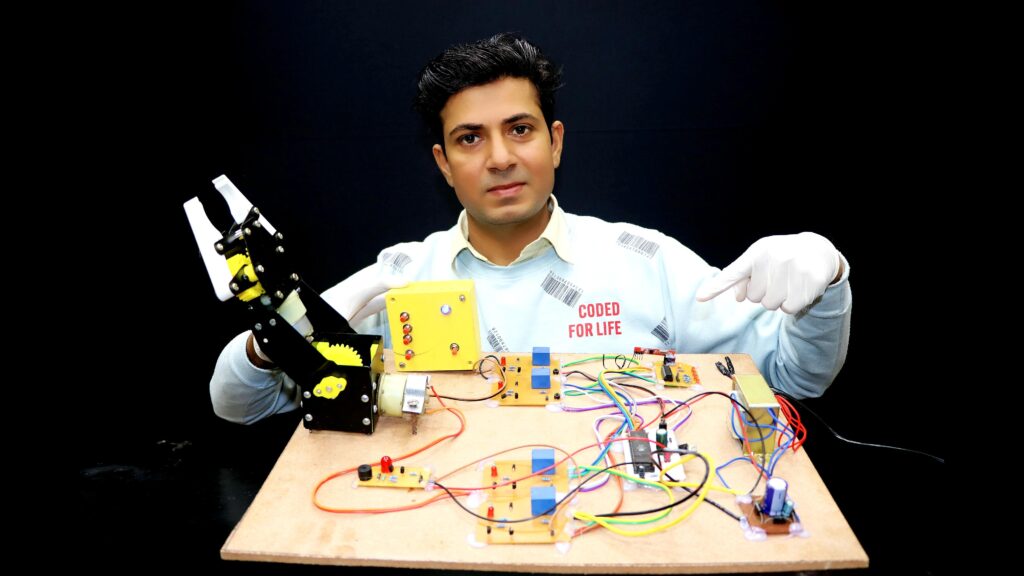8051 Projects, Innovative Engineering Project
RF Controlled Robotic Arm using 8051 Microcontroller | Engineering Project
Introduction:
Radio Frequency (RF) technology has found its application in various fields, and one fascinating area is robotics. In this project, we explore the development of an RF Controlled Robotic Arm using an 8051 microcontroller. The robotic arm is equipped with two DC-geared motors, and the control is facilitated through a 433MHz RF module. The motor control is achieved using a 4-relay module, making it an efficient and versatile project for enthusiasts and beginners in robotics. This project engineering students can make as their college project.
Video Demonstration:
Download Data of the project:- Click Here
Want to Buy the Project Kit:- Click Here OR Contact at +91-8571964488 ( Call or Whatsapp )
Components Used:
8051 Microcontroller:
The brain of the system, the 8051 microcontroller, serves as the central processing unit, managing and executing the control logic for the robotic arm.
433MHz RF Module:
The RF module facilitates wireless communication between the transmitter and receiver components of the system. It allows for remote control of the robotic arm over a considerable distance.
DC-Geared Motors:
Two DC-geared motors drive the robotic arm’s movement. These motors are responsible for controlling the arm’s rotation and extension, providing the necessary mobility.
4-Relay Module:
The relay module acts as the motor driver, enabling the microcontroller to control the direction and speed of the DC motors. It provides a simple and effective way to manage the motor functions of the robotic arm.
Project Implementation:
Transmitter Section:
The transmitter consists of a microcontroller interfaced with an RF transmitter module. The user inputs control signals using switches or buttons, and the microcontroller encodes these signals and transmits them wirelessly via the RF module.
Receiver Section:
The receiver section comprises an RF receiver module connected to the 8051 microcontroller. It receives the encoded signals from the transmitter, decodes them, and instructs the microcontroller to control the robotic arm accordingly.
Motor Control:
The 8051 microcontroller communicates with the 4-relay module to control the DC motors. By activating the appropriate relays, the microcontroller determines the direction and speed of each motor, allowing precise control of the robotic arm’s movements.
Power Supply:
A stable power supply is crucial for the proper functioning of the system. Voltage regulators and power management circuits ensure that the microcontroller, RF modules, and motors receive the required power.
Advantages:
Wireless Control: Enables remote control of the robotic arm through RF communication, providing flexibility.
Versatility: 4-relay module allows precise control of DC motors, making the robotic arm adaptable for various movements.
Educational Value: Offers hands-on experience in microcontroller programming, RF communication, and system integration, making it an educational tool.
Real-world Application: Mimics practical scenarios where remote-controlled robotics is essential, showcasing real-world relevance.
Scalability: Can be expanded with additional features, providing scalability and customization options
Disadvantages:
Interference: Susceptible to interference from other electronic devices, potentially affecting wireless communication reliability.
Complexity for Beginners: Involves multiple components, posing a challenge for beginners in electronics and programming.
Cost: Involves the purchase of multiple components, contributing to the overall project cost.
Maintenance: Like any electronic system, the robotic arm may require periodic maintenance, which could be challenging for users with limited experience.
Conclusion:
The RF Controlled Robotic Arm using an 8051 microcontroller is a versatile and engaging project that combines embedded systems, wireless communication, and robotics. This project not only provides hands-on experience in interfacing different modules but also offers a practical application of microcontroller-based systems in real-world scenarios. As technology continues to evolve, projects like these contribute to the exploration and understanding of cutting-edge advancements in the field of robotics and automation. Experimenting with such projects enhances skills in microcontroller programming, circuit design, and system integration, making it an ideal choice for hobbyists and students alike.

